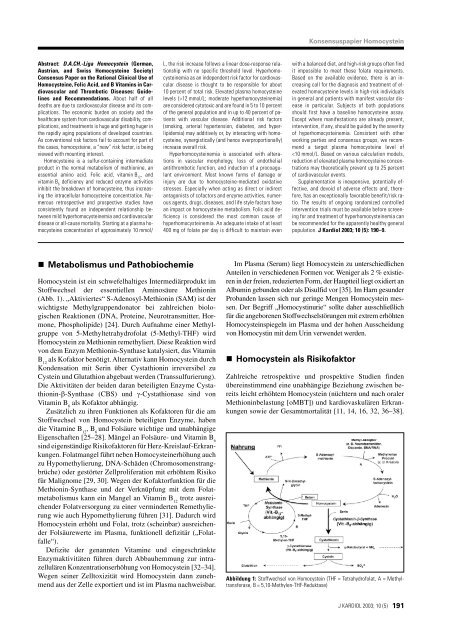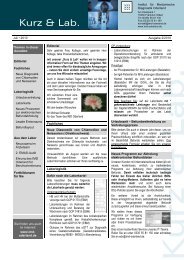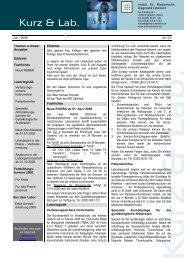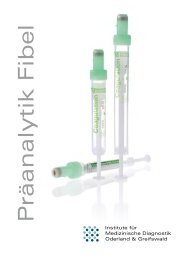Konsensuspapier der DACH.-Liga Homocystein über den ...
Konsensuspapier der DACH.-Liga Homocystein über den ...
Konsensuspapier der DACH.-Liga Homocystein über den ...
Erfolgreiche ePaper selbst erstellen
Machen Sie aus Ihren PDF Publikationen ein blätterbares Flipbook mit unserer einzigartigen Google optimierten e-Paper Software.
<strong>Konsensuspapier</strong> <strong>Homocystein</strong><br />
Abstract: D.A.CH.-<strong>Liga</strong> <strong>Homocystein</strong> (German,<br />
Austrian, and Swiss <strong>Homocystein</strong>e Society)<br />
Consensus Paper on the Rational Clinical Use of<br />
<strong>Homocystein</strong>e, Folic Acid, and B Vitamins in Cardiovascular<br />
and Thrombotic Diseases: Guidelines<br />
and Recommendations. About half of all<br />
deaths are due to cardiovascular disease and its complications.<br />
The economic bur<strong>den</strong> on society and the<br />
healthcare system from cardiovascular disability, complications,<br />
and treatments is huge and getting huger in<br />
the rapidly aging populations of developed countries.<br />
As conventional risk factors fail to account for part of<br />
the cases, homocysteine, a “new” risk factor, is being<br />
viewed with mounting interest.<br />
<strong>Homocystein</strong>e is a sulfur-containing intermediate<br />
product in the normal metabolism of methionine, an<br />
essential amino acid. Folic acid, vitamin B 12<br />
, and<br />
vitamin B 6<br />
deficiency and reduced enzyme activities<br />
inhibit the breakdown of homocysteine, thus increasing<br />
the intracellular homocysteine concentration. Numerous<br />
retrospective and prospective studies have<br />
consistently found an indepen<strong>den</strong>t relationship between<br />
mild hyperhomocysteinemia and cardiovascular<br />
disease or all-cause mortality. Starting at a plasma homocysteine<br />
concentration of approximately 10 mmol/<br />
L, the risk increase follows a linear dose-response relationship<br />
with no specific threshold level. Hyperhomocysteinemia<br />
as an indepen<strong>den</strong>t risk factor for cardiovascular<br />
disease is thought to be responsible for about<br />
10 percent of total risk. Elevated plasma homocysteine<br />
levels (>12 mmol/L; mo<strong>der</strong>ate hyperhomocysteinemia)<br />
are consi<strong>der</strong>ed cytotoxic and are found in 5 to 10 percent<br />
of the general population and in up to 40 percent of patients<br />
with vascular disease. Additional risk factors<br />
(smoking, arterial hypertension, diabetes, and hyperlipidemia)<br />
may additively or, by interacting with homocysteine,<br />
synergistically (and hence overproportionally)<br />
increase overall risk.<br />
Hyperhomocysteinemia is associated with alterations<br />
in vascular morphology, loss of endothelial<br />
antithrombotic function, and induction of a procoagulant<br />
environment. Most known forms of damage or<br />
injury are due to homocysteine-mediated oxidative<br />
stresses. Especially when acting as direct or indirect<br />
antagonists of cofactors and enzyme activities, numerous<br />
agents, drugs, diseases, and life style factors have<br />
an impact on homocysteine metabolism. Folic acid deficiency<br />
is consi<strong>der</strong>ed the most common cause of<br />
hyperhomocysteinemia. An adequate intake of at least<br />
400 mg of folate per day is difficult to maintain even<br />
with a balanced diet, and high-risk groups often find<br />
it impossible to meet these folate requirements.<br />
Based on the available evi<strong>den</strong>ce, there is an increasing<br />
call for the diagnosis and treatment of elevated<br />
homocysteine levels in high-risk individuals<br />
in general and patients with manifest vascular disease<br />
in particular. Subjects of both populations<br />
should first have a baseline homocysteine assay.<br />
Except where manifestations are already present,<br />
intervention, if any, should be guided by the severity<br />
of hyperhomocysteinemia. Consistent with other<br />
working parties and consensus groups, we recommend<br />
a target plasma homocysteine level of<br />





